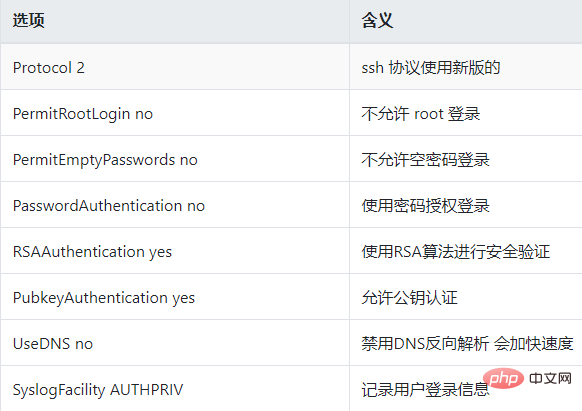 Operation and Maintenance
Operation and Maintenance
 Linux Operation and Maintenance
Linux Operation and Maintenance
 Linux server initialization configuration process
Linux server initialization configuration process
Linux server initialization configuration process

Change the root password
The root account does not have a password by default. For security reasons, initialize one first
passwd
Create Linux administrator account
When using a Linux server, try not to use the root account. To handle daily operations, we create a new administrator account.
First, add a user group (my customized admin here).
addgroup admin
Then, add a new user (assumed to be www).
useradd -d /home/www -s /bin/bash -m www
In the above command, the parameter d specifies the user's home directory, the parameter s specifies the user's shell, and the parameter m indicates that if the directory does not exist, create the directory.
Free learning video tutorial sharing: linux video tutorial
Next, set the password of the new user.
passwd www
Add new user (www) to user group (admin).
usermod -a -G admin www
Next, set sudo permissions for the new user.
sudo vi /etc/sudoers
Find the following line.
root ALL=(ALL:ALL) ALL
Below this line, add another line.
root ALL=(ALL:ALL) ALL www ALL=(ALL) NOPASSWD: ALL
The above NOPASSWD means that you do not need to enter a password when switching sudo. For security reasons, a password can also be enforced.
root ALL=(ALL:ALL) ALL www ALL=(ALL:ALL) ALL
Finally, log out as the root user first, and then log in as the new user.
Configure SSH service
Save your computer’s ssh public key to the server’s ~/.ssh/authorized_keys file
Use the following command directly
ssh-copy-id -i ~/.ssh/id_rsa.pub root@123.456.78
Then, enter the server and edit the SSH configuration file /etc/ssh/sshd_config.
sudo cp /etc/ssh/sshd_config ~ (备份,复原时使用) sudo vi /etc/ssh/sshd_config
In the configuration file, change the default port 22 of SSH. Suppose you use 25000
Port 25000
Then, check whether several settings are set as follows, making sure to remove the # sign in front.

The above mainly prohibits root user login and password login.
After saving, exit file editing.
Next, change the permissions of the authorized_keys file.
sudo chmod 600 ~/.ssh/authorized_keys && chmod 700 ~/.ssh/
Restart SSHD
sudo service ssh restart
or
sudo /etc/init.d/ssh restart
Running environment configuration
Check the regional settings of the server.
locale
If the result is not en_US.UTF-8, it is recommended to set it to it.
sudo locale-gen en_US en_US.UTF-8 en_CA.UTF-8 sudo dpkg-reconfigure locales
Then, update the software
sudo apt-get update sudo apt-get upgrade
Finally, make some security settings as needed, such as setting up a firewall and closing ports other than HTTP, HTTPs, and SSH.
Recommended related articles and tutorials: linux tutorial
The above is the detailed content of Linux server initialization configuration process. For more information, please follow other related articles on the PHP Chinese website!

Hot AI Tools

Undresser.AI Undress
AI-powered app for creating realistic nude photos

AI Clothes Remover
Online AI tool for removing clothes from photos.

Undress AI Tool
Undress images for free

Clothoff.io
AI clothes remover

Video Face Swap
Swap faces in any video effortlessly with our completely free AI face swap tool!

Hot Article

Hot Tools

Notepad++7.3.1
Easy-to-use and free code editor

SublimeText3 Chinese version
Chinese version, very easy to use

Zend Studio 13.0.1
Powerful PHP integrated development environment

Dreamweaver CS6
Visual web development tools

SublimeText3 Mac version
God-level code editing software (SublimeText3)

Hot Topics
 What computer configuration is required for vscode
Apr 15, 2025 pm 09:48 PM
What computer configuration is required for vscode
Apr 15, 2025 pm 09:48 PM
VS Code system requirements: Operating system: Windows 10 and above, macOS 10.12 and above, Linux distribution processor: minimum 1.6 GHz, recommended 2.0 GHz and above memory: minimum 512 MB, recommended 4 GB and above storage space: minimum 250 MB, recommended 1 GB and above other requirements: stable network connection, Xorg/Wayland (Linux)
 Linux Architecture: Unveiling the 5 Basic Components
Apr 20, 2025 am 12:04 AM
Linux Architecture: Unveiling the 5 Basic Components
Apr 20, 2025 am 12:04 AM
The five basic components of the Linux system are: 1. Kernel, 2. System library, 3. System utilities, 4. Graphical user interface, 5. Applications. The kernel manages hardware resources, the system library provides precompiled functions, system utilities are used for system management, the GUI provides visual interaction, and applications use these components to implement functions.
 How to run java code in notepad
Apr 16, 2025 pm 07:39 PM
How to run java code in notepad
Apr 16, 2025 pm 07:39 PM
Although Notepad cannot run Java code directly, it can be achieved by using other tools: using the command line compiler (javac) to generate a bytecode file (filename.class). Use the Java interpreter (java) to interpret bytecode, execute the code, and output the result.
 vscode cannot install extension
Apr 15, 2025 pm 07:18 PM
vscode cannot install extension
Apr 15, 2025 pm 07:18 PM
The reasons for the installation of VS Code extensions may be: network instability, insufficient permissions, system compatibility issues, VS Code version is too old, antivirus software or firewall interference. By checking network connections, permissions, log files, updating VS Code, disabling security software, and restarting VS Code or computers, you can gradually troubleshoot and resolve issues.
 vscode terminal usage tutorial
Apr 15, 2025 pm 10:09 PM
vscode terminal usage tutorial
Apr 15, 2025 pm 10:09 PM
vscode built-in terminal is a development tool that allows running commands and scripts within the editor to simplify the development process. How to use vscode terminal: Open the terminal with the shortcut key (Ctrl/Cmd). Enter a command or run the script. Use hotkeys (such as Ctrl L to clear the terminal). Change the working directory (such as the cd command). Advanced features include debug mode, automatic code snippet completion, and interactive command history.
 How to check the warehouse address of git
Apr 17, 2025 pm 01:54 PM
How to check the warehouse address of git
Apr 17, 2025 pm 01:54 PM
To view the Git repository address, perform the following steps: 1. Open the command line and navigate to the repository directory; 2. Run the "git remote -v" command; 3. View the repository name in the output and its corresponding address.
 Where to write code in vscode
Apr 15, 2025 pm 09:54 PM
Where to write code in vscode
Apr 15, 2025 pm 09:54 PM
Writing code in Visual Studio Code (VSCode) is simple and easy to use. Just install VSCode, create a project, select a language, create a file, write code, save and run it. The advantages of VSCode include cross-platform, free and open source, powerful features, rich extensions, and lightweight and fast.
 Can vscode be used for mac
Apr 15, 2025 pm 07:36 PM
Can vscode be used for mac
Apr 15, 2025 pm 07:36 PM
VS Code is available on Mac. It has powerful extensions, Git integration, terminal and debugger, and also offers a wealth of setup options. However, for particularly large projects or highly professional development, VS Code may have performance or functional limitations.





